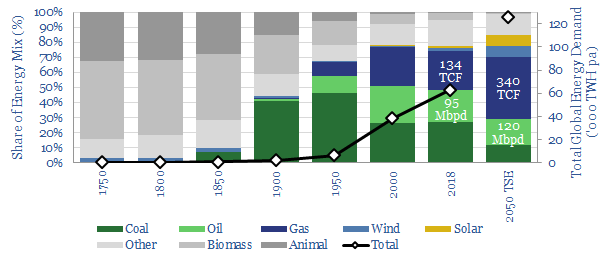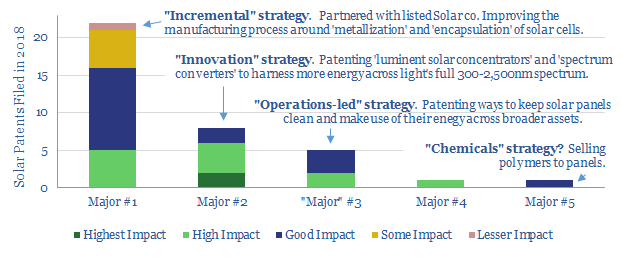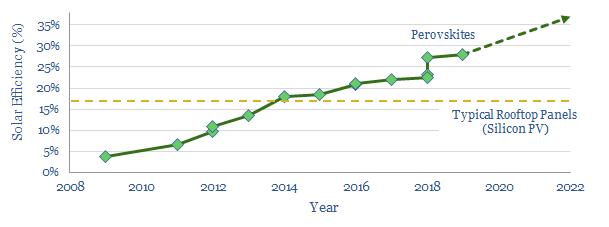Perovskites are the fastest-improving solar innovation. The best test-cells hit a new record of 28% efficiency last year, with line-of-sight to the mid-30s, i.e., 2x more efficient than today’s silicon photovoltaics. A Major is at the cutting edge.
[restrict]
Today’s renewable technologies are not sufficient to deliver a rapid energy transition. On our numbers, the world will still need 120Mbpd of oil by 2050, while the need for gas will treble, even with $300bn pa invested in wind and solar (chart below, model here) .

What can accelerate the transition is next-generation technology, delivering more energy at a lower cost.
In the solar space, the most exciting opportunity we have reviewed so far is Perovskites. Their efficiency has improved faster than any other solar cells, since the first examples were tested in 2009. There is now line-of-sight to reach 2x higher efficiency than today’s solar cells (c17%), for lower costs.
Five Facts about Perovskites
(1) Perovskites are a mineral class (named after a 19th Century Russian Count). They exhibit exceptional optoelectronic properties: A low band gap means it is easy for incoming photons to dislodge electricity (electrons). Low thermalization losses mean that these liberated electrons are effectively conducted to electrodes, without their energy being dissipated.
(2) The most common cell designs sandwich a layer of MethylAmmonium Lead Iodide (band gap of 1.55 eV) in between an ‘electron carrier’ and a ‘hole carrier’, which are in turn sandwiched between a gold cathode and a fluorided tin oxide anode. A 400nm film of this material can absorb almost all photons in visible light.
(3) Costs should in principle be lower than today’s photovoltaics, due to eliminating the intricate and energy-intensive processing of silicon. Instead, Perovskites crystallise out of a solution onto a substrate. c35% of the cost is the “hole transport layer” and c20% is the gold cathode, both of which are being improved.
(4) Constant innovation is taking place in the technical literature. Mixing perovskites with different cations or silicon can improve the stability of the cells, and liberate more electrons. Efficiency is hindered when liberated electrons recombine at the boundaries of Perovskite “grains”, hence these grain boundaries can be “passivated”. Finally, efficiency can also be improved with better transport materials, electrodes and at the interfaces between materials.
(5) Not there yet. We have classified Perovskites at TRL5. So far, most Perovskites degrade within 500-1,000 hours, due to moisture, oxygen and ultra-violet light, while achieving c200-days’ lifespan is documented as remarkable. Outdoor applications have not been proven. The test cells developed in the lab typically cover 1cm x 1cm. And most use lead, which is toxic.
In conclusion, the technology is exciting, and improving rapidly, but it is also long-dated. It requires committed investors who understand the long-term potential…
Driving the Transition
Reviewing patents and technical papers around the energy industry, what has surprised us most is the Oil Majors’ involvement at the cutting edge of next-generation renewables technology. Leading Majors want to drive the transition: strengthening their societal license to operate and capitalising on vast new opportunities in the future energy system.
It is no different in solar. In 2017, Equinor participated in the £31M Series D funding of Oxford PV, the company at the forefront of Perovskite research, and holding the most recent records for Perovskite cell efficiency. Equinor’s involvement will support Oxford PV gear up to a more commercial phase.
This adds to the other Majors’ efforts at the forefront of solar. We have reviewed 37 patents across the group, and have characterised the leading companies’ efforts here (chart below).

[/restrict]
